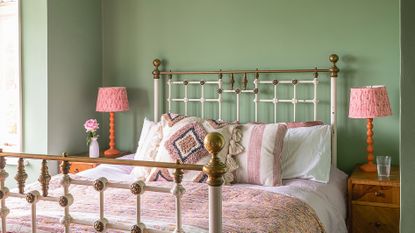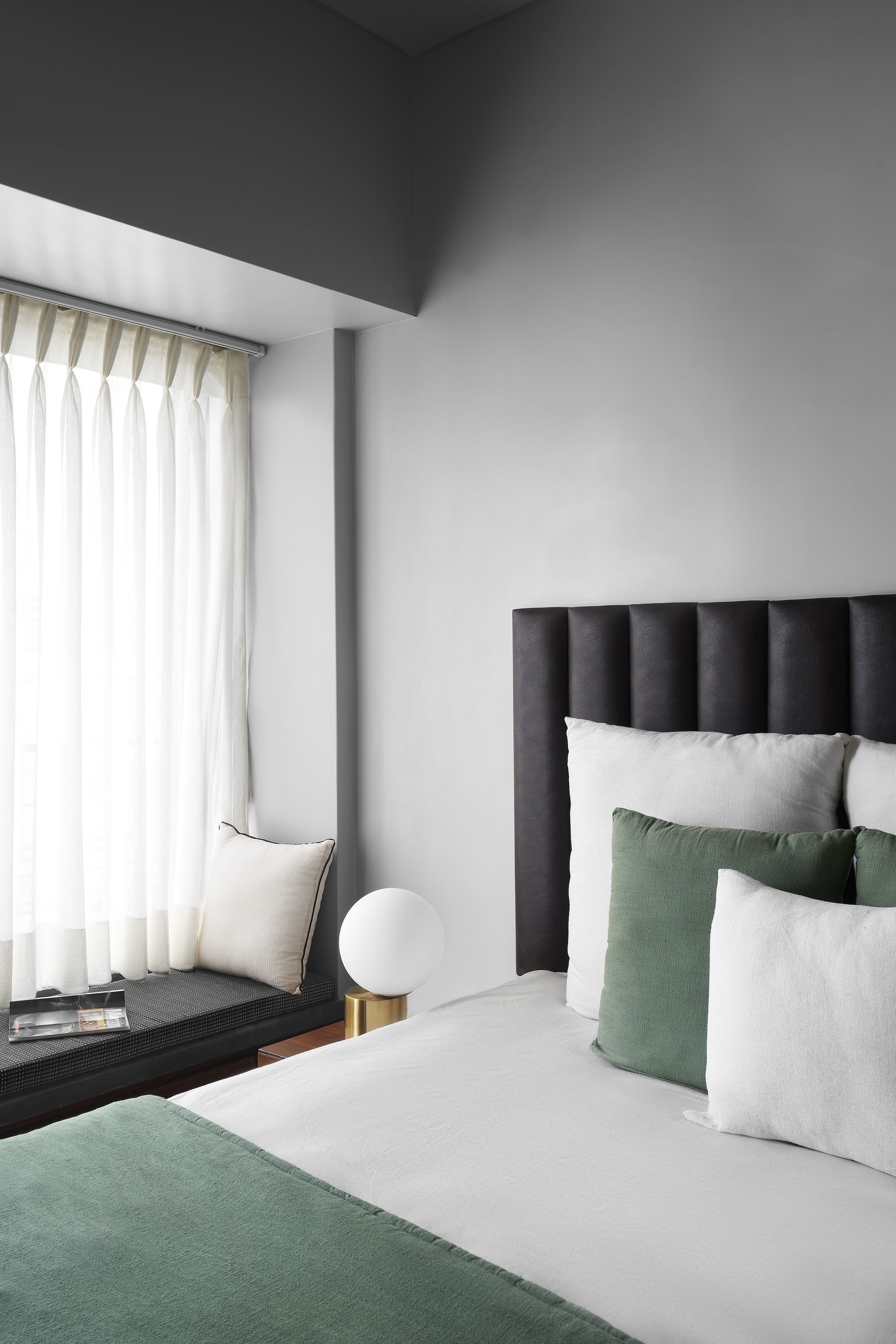5 calming colors to paint a bedroom - design experts on how you can use decor to get a good night's sleep
We have a consensus from designers - these calming colors to paint a bedroom are a must for a peaceful, sleepy space


Choosing calming colors to paint a bedroom can convert your space into a sanctuary. Soothing colors, after all don't only serve decorative purposes. They have a psychological effect on our moods and mind and help create restorative spaces where you can retire after a long day of work.
When it comes to bedroom ideas, certain colors trump over others in terms of their mood-generating abilities. Largely, softer tones do better than warmer ones for designing calmer rooms. But if you do go with bolder hues, it's better to stick to ones on the cooler side of the color wheel, for example, greens, blues, and purples.
Hues like green and grey are known to help lower blood pressure and are associated with rest. Of course, if using their lighter tones makes your room look too flat, you can always punch up the palette with small accents.
'We’ve seen so many homeowners use paint to create a restorative sanctuary in their bedrooms, where they need it most,' says Sue Wadden, of Sherwin-William. 'Because our bedrooms are where we begin and end our days, color can play an important role in setting a positive tone for the day ahead or helping us unwind in the evenings.'
5 calming colors to paint a bedroom that guarantee deep sleep
'We are seeing a lot of bedrooms incorporate grounding and peaceful colors inspired by the earth,' says Sue from Sherwin-William. 'Warm browns, deep greens, and calming blues will be at the forefront as homeowners are bringing the outdoors in through design. I recommend painting it on all four walls in a bedroom for a cozy, cocooning feeling.'
If you want to turn your bedroom into the most meditative space, then these are the paint colors to incorporate.
1. Pink

'This one quote always comes to mind when I think of pink – 'If pink was a gesture, it would be a hug',' says Natalie Tredgett, founder of Natalie Tredgett Design. 'There was a psychological study that was conducted where pink was used in an environment where normally people would be a little rowdy, but the color soothed them, and made them calmer. This is an incredible hue and when used in its pastel tones, can change the mood of the bedroom.'
'Unfortunately, people have certain stereotypes about pink,' says Natalie. 'They associate it with a young person, who usually tends to be female. Sometimes it's not always easy to convince an adult to live in a pink room because it feels childish to them. In that case, the colors I suggest are blues and pale greens, but in their pastel tones.'
Its mood-enhancing abilities aside, pink is a versatile hue for the modern bedroom that also happens to flatter most skin tones, making it a great choice in bedrooms. If you're unsure of pastels, perhaps choose one that has a touch of brown, making it less pastel and more neutral. It can easily be paired with wood details, conjuring up a cocooning scheme.
2. Blue

If you think about it, blue is a universally liked color, perhaps because it's available in so many tones. Think deep blue, sky blue, aqua, royal or inky blue, and then there's the whole wide world of blue with different undertones. There's a blue for everyone.
On this important topic of calming bedrooms, it's important to note that soothing and restful doesn't necessarily have to mean boring beige or white or, even lighter tones. The stress-reducing blue color can stand on its own or be used as an accent tone, complementing other colors. Overall, it is believed that this color for the master bedroom helps you sleep better.
'A Travelodge survey of 2,000 U.K. homes looked into how the color of bedrooms impacts quality and duration of sleep,' Jude Stewart, a design writer and author of the book ROY G. BIV: An Exceedingly Surprising Book About Color. 'Blue was the clear winner: blue-drenched sleepers clock in an average of seven hours and 52 minutes of nightly shut-eye. Since the hue is associated with the feeling of calmness, it helps people relax better.'
In terms of tones, you can choose blue-greens, blues with grey or brown undertones, or the deep, moody royal blue. 'I love navy and have it in almost every room,' says Jennifer Morris, interior designer and founder of JMorris Design. 'I never tire of the bold but soothing feel it gives me. It’s classic like black but is just a touch softer and richer.'
3. Grey

A few decades ago grey was the all-trending hue, seen across interiors and commercial spaces but today it is a color that isn't overly used anymore. All except the bedrooms, where it still has a rightful place. That's because light greys are inherently calming and can create the most restful interior.
Medium greys, grey with brown, yellow, or beige undertones, have a cozy feel to them. Plus, several colors go with grey so it acts as a wonderful neutral to lift other hues in the room. For painting your walls, consider North Star 6246 by Sherwin-Williams for a calming shade.
'Grey has always stuck around throughout the years and plays a critical role in interior design,' says Shoshanna Shapiro, principal designer at Sho and Co. 'Especially when paired with trending textures, such as wicker, cane, brass and other earthy elements, grey balances out so nicely. It’s my favorite color to use, especially in warm tones as it’s such as staple neutral. I recommend it with other neutrals, such as black, white, and beige.'
4. Peach

The color peach, as with most trends, has come back around like a revolving door. While back in the 80s it was considered a hip color, today it is that warm, balmy hue that can ground your scheme.
Peach looks great, especially in lime wash paint colors. The hue brings out the textural quality of the plaster paint, gives the room a tactile feel, and even helpyou if you're wondering how to get a good night's sleep.
'In terms of using these hues, I like using paints on all walls. As opposed to the general opinion, using color all over doesn't increase its boldness,' says Natalie. 'In fact, it softens it. If you were to use paint on an accent wall, due to its contrast with other colors, the hue will stand out and give off more vibrancy. Alternatively, if you're after calmness, the more you use the color, the calmer its effect becomes. Saturate your walls in pale peach and use complementary tones in your upholstery to make the room serene.'
5. Green

It reminds us of the lush fields, the tall trees, and fresh vegetables. Green has a warm side with yellowy chartreuse and lime greens. It is a color that can have a minty or watery green tone. With grey undertones, it looks somber and calming. Sage green bedrooms look incredibly cozy and are currently quite popular.
Green is a hue seen abundantly in nature and has an immediate relatability element to it. Sleeping in a green bedroom can make one feel as if resting in the plush, freshly mown grass outside.
‘A dark green is particularly effective for giving a soothing feeling in rooms where we seek comfort such as a bedroom,’ says Ruth Mottershead, Creative Director of Little Greene. ‘Dark greens make us feel reassured and comfortable,’ agrees Dominic Myland, CEO of Mylands. ‘Because they’re so prevalent in nature, they bring a sense of calm to a space and help us feel connected to the outside world.’
What wall colors help with anxiety?

Largely it is believed that green is a quiet and restful tone that can invite harmony and diffuse anxiety. Blue too is a peaceful tone and can encourage a sense of calm. Even in the most modern bedrooms, these make a mark and are universally loved.
'Blue and green bring a dose of freshness because of their association with nature,' says Natalie. 'While blue reminds us of the calm water, green of trees. These tones are also more widely accepted, across genders. The key in my opinion is the saturation of the color; the paler the color, the more washed out and soothing it feels.'
Be The First To Know
The Livingetc newsletter is your shortcut to the now and the next in home design. Subscribe today to receive a stunning free 200-page book of the best homes from around the world.
Aditi Sharma Maheshwari is an architecture and design journalist with over 10 years of experience. She's worked at some of the leading media houses in India such as Elle Decor, Houzz and Architectural Digest (Condé Nast). Till recently, she was a freelance writer for publications such as Architectural Digest US, House Beautiful, Stir World, Beautiful Homes India among others. In her spare time, she volunteers at animal shelters and other rescue organizations.
-
 The 12 Best Table Lamps for Reading —I'm a Certified Bookworm (and Shopping Expert)
The 12 Best Table Lamps for Reading —I'm a Certified Bookworm (and Shopping Expert)When it comes to table lamps for reading, I don't mess around. If you're the same, this edit is for YOU (and your books, or course — and good recommendations?)
By Brigid Kennedy Published
-
 "It's Scandi Meets Californian-Cool" — The New Anthro Collab With Katie Hodges Hits Just the Right Style Note
"It's Scandi Meets Californian-Cool" — The New Anthro Collab With Katie Hodges Hits Just the Right Style NoteThe LA-based interior designer merges coastal cool with Scandinavian simplicity for a delightfully lived-in collection of elevated home furnishings
By Julia Demer Published

